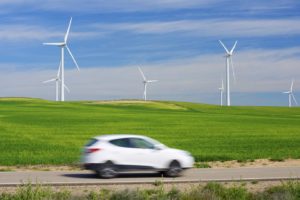TRANSPORT AND CLIMATE CHANGE
DECARBONISATION OF EU TRANSPORT
The next edition of the annual United Nations Framework Convention on Climate Change (UNFCCC) Conference takes place in Bonn, Germany from 6th – 17th November. The Government of Fiji is presiding over the meeting (known as COP23) where countries come together to continue their efforts to combat climate change and to adapt to its effects.*
The Paris Agreement
A focus of the discussions at COP23 will be the Paris Agreement, which was agreed within the framework of the UNFCCC and focuses on delivering global action to reduce greenhouse gas emissions. It was signed on 22nd April 2016 and negotiated by representatives of 196 parties. The aim of the Agreement is to keep the global temperature rise to below 2° C by the end of the century with every effort being made to keep this to 1.5° C. The discussion in Bonn will focus on how the Paris Agreement will be delivered in practice.
Under the Agreement, countries are required to reduce their greenhouse gas emissions and to report their progress and plans on a regular basis. This will require actions in all sectors of the economy, with transport in particular being seen as particularly problematic.
Why 2° C?
Governments settled on the 2°C threshold largely because scientists have warned of severe consequences if temperatures rise above this figure, including higher sea levels, droughts and heatwaves. The aspiration in the Paris Agreement to limit warming to no more than 1.5° C would increase the chances of avoiding the worst of the potential impacts of climate change. However, this aim is ambitious, particularly considering the progress with greenhouse gas emissions reductions to date.
Greenhouse Gas Emissions from EU Transport
Carbon dioxide (CO2) is by far the most common greenhouse gas that is emitted by the transport sector. Since the financial crisis, CO2 emissions from transport in the EU had been decreasing, but have recently started to increase again as the EU’s economy recovers. To date, actions have been taken to reduce transport’s CO2 emissions, but a lot more needs to be done to deliver the necessary emission reductions. The EU is about to make some crucial decisions on its CO2 reduction policy framework for transport, particularly with respect to CO2 emissions from cars and vans.
The Way Forward from TEPR and CE Delft
TEPR and CE Delft were commissioned by the European Parliament to write a report on the ‘Decarbonisation of EU Transport’. It reviews the EU policy framework, including progress to date, and identifies the potential way forward for policy action to meet long-term GHG reduction targets. The report underlined the need for early action to reduce CO2 emissions; the earlier action is taken, the less CO2 will be emitted, thus improving the chances of avoiding the worst of climate change.
For more information and to read the report in full, go to the ‘low carbon transport’ projects page of TEPR’s website. TEPR is an independent research consultancy working for the implementation of sustainable, low carbon transport solutions in the UK and within the EU. Call today on +44 (0)7521 063324.
*http://unfccc.int/paris_agreement/items/9485.php


Trackbacks & Pingbacks
[…] dioxide is one of the main greenhouse gases and therefore one of the gases responsible for climate change. Vehicle tax rates for new cars are dependent on carbon dioxide emissions and so the lower the […]
[…] 1 Carbon dioxide is the main pollutant emitted by transport than contributes to global warming and climate change […]
[…] 2 Carbon dioxide is the main pollutant emitted by transport than contributes to global warming and climate change […]
Leave a Reply
Want to join the discussion?Feel free to contribute!